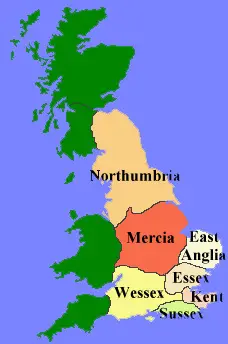|
The Anglo-Saxon Heptarchy Part 2: Kent and MerciaKENT 
The Saxons and the Britons fought together for a time but then fell to fighting against each other. The Anglo-Saxon Chronicle says that this dispute occurred as early as 455, just six years after the Saxon landing. A Chronicle entry for two years after that says Hengist and his forces killed 4,000 Britons, driving them out of Kent entirely. Æthelbert is the earliest name mentioned as being a king of the Kentish kingdom. This king instituted a set of laws, commonly known as the Law of Æthelbert, that, some sources say, is the oldest surviving example of Old English. One unifying source among the Germanic peoples was the introduction of Christianity. A monk named Augustine (later named St. Augustine) arrived in Canterbury, the capital of Kent, in 597. Augustine, on a mission authorized by the Catholic Pope Gregory I, found a warm welcome from Æthelbert, in large part because the king's wife was already a practicer of the Christian religion. Ethelbert believed in another religion; but his wife, Bertha, and Augustine soon had the king converted to Christianity. That kind of conversion became commonplace throughout Anglo-Saxon Britain. Even though Kent can claim prominence in the earliest Anglo-Saxon settlements and Æthelbert was one of the most powerful rulers in the entirety of the early settlements, the Kingdom of Kent held less and less power as the Germanic migrations progressed. MERCIA The most well-known early king of Mercia was Penda, who was quite a success on the battlefield. Mercia and Northumbria had a rivalry that bordered on pure spite. Penda found allies willing to fight with him against Northumbrian forces several times. Against two Northumbrian kings, Edwin and Oswald, Penda was successful. In 655, however, Northumbria, under King Oswiu, prevailed; in fact, at the Battle of Winwaed, Penda himself was killed. Penda's sons carried on their father's legacy, to greater and lesser degrees, and Mercia was, at turns, beholden to Northumbria and independent. An 8th-Century leader named Æthelbald ruled Mercia for more than 40 years and faced down challenges from powerful kings in Kent and Wessex. For a time, Æthelbald was the effective ruler of all kingdoms south of the Humber River (leaving out only Northumbria). A bodyguard killed Æthelbald, and civil war ensued. The winner of that internal struggle was Offa, who became Mercia's most famous king. Offa was a powerful presence, military and politically. He was a visionary who saw the need for a strong defense and a strong economy. He set about pursuing both. Among his more far-reaching programs were the establishment of market towns, the issuing of gold coins, and the construction of Offa's Dyke, a huge man-made earthen structure that effectively approximated the border between Mercia and Wales. Offa was one of early England's most famous names, and he ruled for a few decades. His dyke still exists, even if his rule doesn't. His son Ecgfrith didn't have the power that his father did, nor did his brother, and Mercia struggled on for its independence until being eclipsed by first Wessex and then Viking kingdoms. The last independent king of any part of Mercia was Ceolwulf, who ruled only the western half and that only until 879. Important settlements in Mercia included Derby, Leicester, Lichfield, and Lincoln. |
|
Social Studies for Kids
copyright 2002–2024
David White


